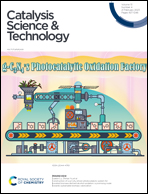Enhancing the anisole hydrodeoxygenation activity over Ni/Nb2O5−x by tuning the oxophilicity of the support†
Abstract
The present work focuses on designing a robust non-noble metal-based niobia-supported catalyst with a high number of oxygen vacancies for an efficient HDO activity of anisole. Various synthesis procedures, such as hydrothermal (Nb2O5-HT), precipitation (Nb2O5-P) and hydrolysis (Nb2O5-H), are adopted for the preparation of the Nb2O5 support, followed by 3 wt% Ni impregnation. As a benchmark, Ni has also been impregnated on commercial Nb2O5 (Nb2O5-C). The catalysts display a large discrepancy in surface areas, the crystallite size of Nb2O5 and NiOx, strong metal–support interaction (SMSI), active interfacial Ni–NbOx species and oxygen vacancies. In particular, Ni impregnated on Nb2O5-H (Ni/Nb2O5-H) possesses the highest amount of oxygen vacancies (202 μmol g−1) (O2-temperature programmed desorption), which is 1.1 and 3.5 fold higher than that for Ni/Nb2O5-HT and Ni/Nb2O5-P, respectively, indicating the importance of the synthesis procedure of the support. Interestingly Ni/Nb2O5-H has 200-fold higher oxygen vacancies than Ni/Nb2O5-C. Likewise, Ni/Nb2O5-H possesses a high Ni3+/Ni2+ and Nb4+/Nb5+ ratio, based on X-ray photoelectron spectroscopy, suggesting high dispersion of small NiOx particles on the NbOx surface, facilitating the redistribution of the electrons at the interface of NiO and Nb2O5 due to SMSI. This leads to the formation of active interfacial Ni–NbOx species and oxygen vacancies (confirmed by H2-TPD and XPS), contributing to the activation of hydrogen and anisole adsorption and thereby improving HDO activity substantially. At similar conversions of anisole, Ni/Nb2O5-H exhibits the highest rate of HDO of 0.63 mmol min−1 g−1, which is 1.4 to 3.2 fold higher than those of the other catalysts, including Nb2O5-C. Under optimised reaction conditions, Ni/Nb2O5-H shows a remarkable activity towards HDO of anisole with an excellent selectivity to cyclohexane (96.5%) at the near-quantitative conversion of anisole (>98%) at 240 °C, 20 bar H2, 2 h. Ni/Nb2O5-H also displays good to excellent activity towards various lignin-based model compounds, affording 50–96% cyclohexane yield.



 Please wait while we load your content...
Please wait while we load your content...